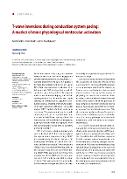T-wave inversions during conduction system pacing: A marker of more physiological ventricular activation

Datum vydání
2022Publikováno v
Kardiologia PolskaRočník / Číslo vydání
80 (10)ISBN / ISSN
ISSN: 0022-9032Metadata
Zobrazit celý záznamKolekce
Tato publikace má vydavatelskou verzi s DOI 10.33963/KP.a2022.0246
Abstrakt
Permanent myocardial pacing can preserve adequate heart rates and improve symptoms and mortality in patients with bradycardia. Conventional right ventricular (RV) pacing is far from the optimal treatment since up to 20% of patients experience a reduction in the left ventricular (LV) ejection fraction, which can lead to heart failure (HF). This was the main incentive for developing 'conduction system pacing (CSP)' techniques that target (directly or indirectly) the capture of conduction tissue, initiating more physiological ventricular activation. Although His bundle pacing (HBP) leads to the best ventricular synchrony, proper positioning is complicated, requires high pacing thresholds, and is associated with lower sensing values. For these reasons, left bundle branch area pacing (LBBAP), where the lead tip is deployed in the left subendocardial septal area, is currently preferred over HBP.
Klíčová slova
Humans, Heart Conduction System, Arrhythmias, Cardiac, Cardiac Pacing, Artificial, Electrocardiography
Trvalý odkaz
https://hdl.handle.net/20.500.14178/1683Licence
Licence pro užití plného textu výsledku: Creative Commons Uveďte původ-Neužívejte dílo komerčně-Nezpracovávejte 4.0 International







